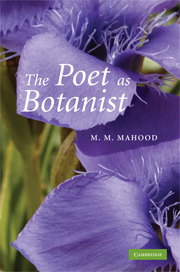Book contents
- Frontmatter
- Contents
- List of illustrations
- Acknowledgements
- A note on quotations
- Introduction
- 1 Primroses at Dove Cottage and Down House
- 2 Erasmus Darwin's feeling for the organism
- 3 Crabbe's slimy mallows and suffocated clover
- 4 John Clare: bard of the wild flowers
- 5 Ruskin's flowers of evil
- 6 D. H. Lawrence, botanist
- 7 Poetry and photosynthesis
- Index of persons
- Index of plants
Introduction
Published online by Cambridge University Press: 22 September 2009
- Frontmatter
- Contents
- List of illustrations
- Acknowledgements
- A note on quotations
- Introduction
- 1 Primroses at Dove Cottage and Down House
- 2 Erasmus Darwin's feeling for the organism
- 3 Crabbe's slimy mallows and suffocated clover
- 4 John Clare: bard of the wild flowers
- 5 Ruskin's flowers of evil
- 6 D. H. Lawrence, botanist
- 7 Poetry and photosynthesis
- Index of persons
- Index of plants
Summary
This is a book about the ways in which poets see plants. More exactly it is an attempt to record something of poets' perceptions of the richness and intricacy and life-giving importance of the plant world as these have been revealed in the generations since Linnaeus made botany big science. At least, that is its field, or scope. But like a plant, a book requires a supply of energy, a driving force; and to define that force I have to have recourse to a fragment of autobiography.
Many years ago, I came round from an emergency operation to find myself in a tropical hospital. Around me were all the mysterious comings and goings that belong to such an occasion. Then, as the bustle died down, one stranger more (the matron, I was later to discover) placed a small bowl of white flowers by my bed. ‘Just watch those’, she said before she, too, disappeared. So I lay and watched as the flowers changed – for they were Hibiscus mutabilis, blushing hibiscus – from white to shell pink, thence to a deeper pink, and finally, as night fell, to red. I meanwhile, transfused with fresh blood as they with pigment, came off the danger list. Next morning the bowl had gone, leaving my mind, now re-activated, busy with two questions. What was this empathy that during those fragile hours had caused me to feel I was being brought back to life by the flowers? And what made the blushing hibiscus blush?
- Type
- Chapter
- Information
- The Poet as Botanist , pp. 1 - 6Publisher: Cambridge University PressPrint publication year: 2008



